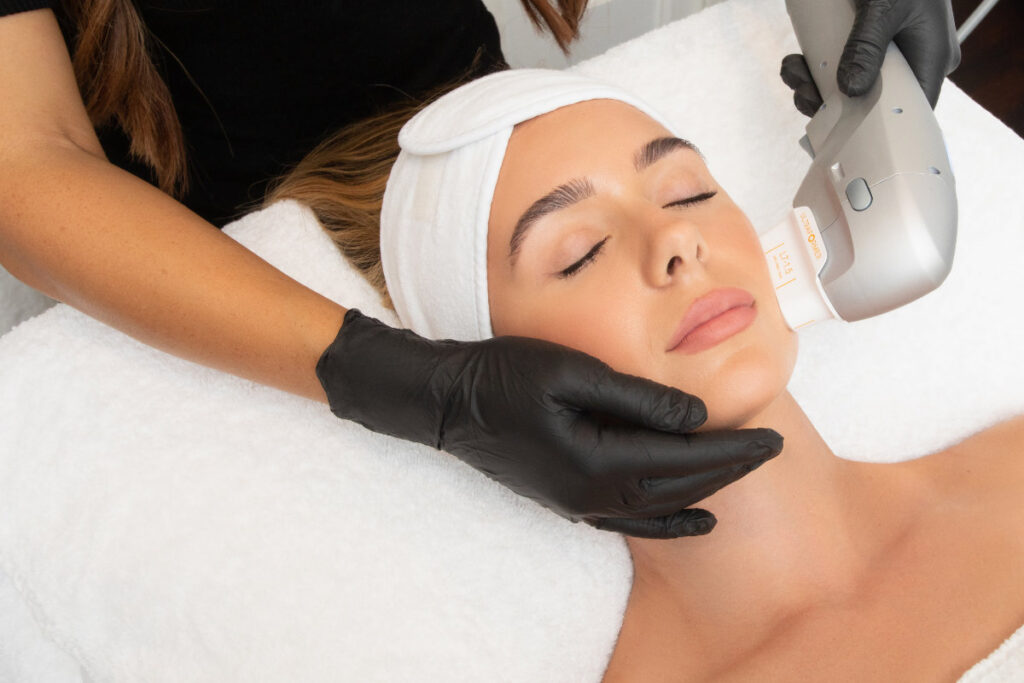
Melasma is a chronic pigmentation condition that affects many people across Australia, particularly those exposed to high levels of ultraviolet (UV) light. In Perth, where sunshine is abundant year-round, the risk of developing or worsening melasma is significantly heightened.
Melasma is not physically harmful, but it often leads individuals to seek medical advice due to its appearance and persistence. At Clinispa, led by Dr. Guy Watts, Specialist Plastic & Reconstructive Surgeon, our patients receive medically guided care for pigmentation concerns that is evidence-based, and tailored to their unique needs. As part of our broader approach to managing skin concerns in Perth, we consider how factors like sun exposure, skin type, and lifestyle may influence pigmentation and overall skin health. This blog explores what melasma is, why it develops, and how it can be carefully managed in a clinical setting.
What Does Melasma Look Like?
Melasma appears as areas of darker pigmentation on the skin, usually presenting in a symmetrical pattern across both sides of the face. The pigmentation may appear as flat, blotchy patches that vary in colour from light brown to dark grey-brown, depending on how deep the pigmentation sits within the skin layers. These patches often emerge gradually, becoming more pronounced over time, especially in response to sunlight or hormonal changes.
The most common sites include the cheeks, forehead, nose, upper lip, and jawline. In some individuals, melasma may extend beyond the face to the forearms or upper chest, particularly in those with significant sun exposure. However, facial involvement is by far the most frequent and concerning for patients.
One of the difficulties in managing melasma is that it is often mistaken for other forms of pigmentation such as sunspots, freckles, or post-inflammatory hyperpigmentation. At Clinispa in Perth, skin assessments are performed with care to differentiate between these conditions. The team use visual examination, medical history review, and, in some cases, specialised imaging to accurately identify melasma and determine its depth – whether it’s epidermal, dermal, or mixed. This classification helps guide appropriate treatment selection.
Why Does Melasma Develop?
Melasma arises due to a combination of genetic, hormonal, and environmental factors. While its precise mechanism is not fully understood, several well-established contributors have been identified.
Sun exposure remains the most significant external factor. UV radiation stimulates the activity of melanocytes—the cells responsible for producing melanin—leading to excessive pigment formation in affected areas. This response can occur even with incidental sun exposure, such as walking outdoors for short periods or driving in daylight without sun protection. In Perth’s high-UV environment, this makes consistent sun protection essential not only in summer, but all year round.
Hormonal fluctuations are another key factor, particularly in women. Melasma is frequently observed during pregnancy, earning it the nickname “the mask of pregnancy.” It also occurs in individuals using oral contraceptives or undergoing hormone replacement therapy. Oestrogen and progesterone are thought to increase the sensitivity of melanocytes to sunlight, exacerbating pigment production.
Genetics also play a role. People with a family history of melasma are more likely to develop the condition themselves, suggesting a hereditary predisposition.
Skin type matters as well. Individuals with darker skin tones (Fitzpatrick skin types III to V) are more prone to melasma due to having more active melanocytes. This means that even minor triggers—like a heatwave or low-level sun exposure—can provoke flare-ups in predisposed skin.
Other aggravating factors may include the use of certain medications such as anti-seizure drugs, photosensitising cosmetics or skin care products, and exposure to infrared heat from cooking or saunas. The combination of internal and external influences makes melasma uniquely challenging to manage, especially without tailored medical oversight.
Who Typically Experiences Melasma?
Melasma most commonly affects women between the ages of 20 and 50, particularly those with a history of hormonal changes related to contraception, pregnancy, or menopause. It is also prevalent among individuals with darker complexions, including those of Mediterranean, Asian, Middle Eastern, or Latin American descent.
Although melasma is less frequent in men, it does occur and is often underdiagnosed in this group. Men who experience melasma may do so due to genetic predisposition, sun exposure, or certain medications, and should not hesitate to seek professional advice.
The onset of melasma often coincides with life stages involving hormonal shifts or increased sun exposure. Many patients notice that their pigmentation darkens in summer and improves slightly in cooler months. At Clinispa, our team assess patients holistically, accounting for medical history, lifestyle, sun exposure patterns, and skin tone in order to create safe, effective management plans.
Is Melasma Permanent?
Melasma is not permanent, but it is considered a chronic condition due to its tendency to recur. In some cases, it may improve spontaneously after the cessation of hormonal triggers—such as following childbirth or discontinuation of oral contraceptives. However, for most patients, melasma requires ongoing management.
The pigmentation may fade with dedicated treatment, but without consistent care, it often reappears—especially during periods of unprotected sun exposure or renewed hormonal changes. This is why melasma is best viewed as a long-term skin condition rather than something that can be “cured” quickly. These same factors can also contribute to the gradual formation of facial wrinkles, making a holistic approach to skin ageing even more important.
At Clinispa Perth, patients are supported with this long-term perspective in mind. Management focuses not just on lightening pigmentation, but also on preventing future flare-ups. This includes daily sun protection, pigment-suppressing skin care, and regular clinical monitoring. Dr. Guy Watts, as a Specialist Plastic & Reconstructive Surgeon, gives patients realistic recommendations grounded in clinical evidence.

How is Melasma Managed at Clinispa in Perth?
Melasma treatment is multifaceted, involving prevention, correction, and maintenance. Every plan at Clinispa is customised according to the type and depth of melasma, the patient’s skin type, and their treatment history. The key components of care include:
✓ Sun Protection
Daily, consistent sun protection is the foundation of melasma management. Patients are advised to use broad-spectrum sunscreens with SPF 50+ that contain physical blockers like zinc oxide or titanium dioxide. These reflect rather than absorb UV rays, offering more effective defence for sensitive skin. Additional measures such as wearing wide-brimmed hats, sunglasses, and protective clothing are also recommended. In Perth’s high-UV environment, sun protection must be part of everyday life, even on cloudy days.
✓ Topical Treatments
Medical-grade creams may be prescribed to reduce pigmentation. These often include hydroquinone (a melanin production inhibitor), azelaic acid, kojic acid, and tretinoin (a retinoid that increases skin cell turnover). Some patients benefit from compound formulas that combine these ingredients to maximise their effects. Products are introduced gradually to reduce irritation and are monitored regularly to avoid side effects.
✓ Chemical Peels
Superficial chemical peels, such as glycolic acid or salicylic acid, can help exfoliate the upper layers of skin and fade surface-level pigmentation. These are generally used cautiously and only in selected cases, particularly in individuals with darker skin tones who are more prone to post-inflammatory pigmentation.
✓ Light-Based Therapies
Laser and IPL treatments may be considered for patients who do not respond to topical therapies. However, melasma does not always respond predictably to laser treatment and can, in some cases, worsen. At Clinispa, these options are only explored under careful supervision and often as part of a broader treatment plan.
✓ Maintenance and Supportive Skincare
Long-term melasma care involves using antioxidant-rich and pigment-regulating skincare products that support the skin barrier and help prevent relapse. Moisturisers, gentle cleansers, and anti-inflammatory agents are often prescribed to keep the skin healthy and resilient.
Every treatment plan is designed with the patient’s comfort, safety, and skin goals in mind. Dr. Guy Watts and the Clinispa team in Perth take a conservative, patient-first approach that prioritises long-term skin health over short-term results.
Why Individualised Care Matters
Melasma varies significantly from person to person. What works for one individual may not be appropriate for another, which is why generic treatments or “one-size-fits-all” skincare often fall short—or worse, cause harm.
At Clinispa, personalised care means assessing each case in detail. Factors such as hormone levels, skin sensitivity, previous treatments, lifestyle habits, and even occupational sun exposure are taken into account. As a medically trained clinicians, we make sure that no treatment is started without understanding the patient’s broader health context.
This level of individualisation is especially important in Perth, where lifestyle and environmental factors like beach-going, outdoor sports, and harsh UV levels make managing pigmentation a continual process. Curious about treatment costs? Visit our Update on Pricing page to learn more.
FAQs About Melasma
How do I know if my pigmentation is melasma or something else?
Melasma typically appears as symmetrical patches of brown or greyish-brown discolouration on the face—most often on the cheeks, forehead, and upper lip. However, other conditions such as sunspots, freckles, or post-inflammatory hyperpigmentation can appear similar. A professional consultation is essential to correctly diagnose the pigmentation and determine the appropriate treatment pathway.
Can melasma go away on its own?
Melasma may fade over time if the triggering factors—such as pregnancy or certain medications—resolve. However, in most cases, it tends to persist or return, especially without appropriate sun protection or skin care. Managing melasma typically requires a long-term, preventive approach guided by a qualified medical professional.
Is melasma dangerous?
Melasma is a benign (non-cancerous) condition and does not pose any risk to physical health. However, many individuals find it frustrating due to its chronic nature and visibility. Professional management can help reduce its appearance and prevent unnecessary irritation from self-treatment.
Are there any specific triggers I should avoid if I have melasma?
Yes. Sun exposure is the most common trigger, so daily use of high-SPF sunscreen and physical protection like hats is essential. Other triggers may include hormonal changes (e.g. pregnancy, contraceptives), heat, stress, and the use of skin care products that irritate or sensitise the skin. Identifying and avoiding these triggers is an important part of melasma management.
What types of skincare ingredients are helpful for melasma?
Medical-grade ingredients such as hydroquinone, azelaic acid, kojic acid, and retinoids are commonly used to reduce pigment production and support skin renewal. Antioxidants and anti-inflammatory ingredients also help protect the skin and improve treatment outcomes. These should only be used under professional guidance to reduce the risk of irritation.
Can I treat melasma with laser or light therapy?
Laser and IPL treatments can be helpful in some cases, but they must be used cautiously. Inappropriate or overly aggressive use of laser devices may worsen melasma. At CLINISPA, such treatments are only recommended after a thorough assessment and are often combined with topical therapies to maximise safety and results.
Will melasma return after treatment?
Melasma is known for its tendency to recur, particularly if sun protection is inconsistent or hormonal triggers remain present. Ongoing maintenance with prescribed skincare and lifestyle adjustments is essential for keeping pigmentation under control. Regular follow-up with your treating practitioner helps monitor progress and prevent flare-ups.
Medical References
- Melasma: MedlinePlus Medical Encyclopedia – MedlinePlus – https://medlineplus.gov/ency/article/000836.htm
- Global research trends on melasma: a bibliometric and visualized analysis – Frontiers in Pharmacology – https://www.frontiersin.org/journals/pharmacology/articles/10.3389/fphar.2024.1421499/full
- Medical Management of Melasma: A Review with Focus on Topical Treatments – PMC (NIH) – https://pmc.ncbi.nlm.nih.gov/articles/PMC5724303/
- Melasma – Tulane School of Medicine – https://medicine.tulane.edu/tulane-doctors/dermatology/melasma
- Melasma – Aga Khan University Hospital – http://hospitals.aku.edu/pakistan/diseases-and-conditions/Pages/melasma.aspx
When to Seek a Professional Consultation
You should consider consulting a qualified clinician if:
Attempting to manage melasma without professional guidance can lead to adverse outcomes, including post-inflammatory hyperpigmentation, uneven results, or prolonged discolouration.
- Your pigmentation is getting darker, expanding in size, or appearing in new areas.
- Over-the-counter products have had no effect or caused skin irritation.
- You’re unsure if the pigmentation is melasma or another condition such as sunspots, acne scarring, or hormonal-related pigmentation.
- You’ve experienced recurring episodes despite past treatments.
The Clinispa PerthTeam provide comprehensive assessments that include medical and aesthetic considerations. With professional care, patients can avoid ineffective or potentially damaging treatments and instead follow a plan that is both safe and clinically sound.
Navigating Melasma Treatment
Living with melasma can be frustrating, especially when it doesn’t respond to conventional skin care products or cosmetic treatments. However, it is a manageable condition when approached with the right tools, the right information, and the right clinical support.
At Clinispa, patients in Perth benefit from expert knowledge, personalised care, and an environment committed to long-term skin health. Whether you are just starting to notice signs of pigmentation or have been managing melasma for years, this concerns blog is your guide to understanding the condition and taking informed next steps.
To learn more or arrange a professional consultation, contact the team at Clinispa Perth. Evidence-based care for melasma is within reach – with guidance that prioritises your skin, your safety, and your goals.
Further Reading
- Read more about Dermamelan Peel
- Read more about Restore Facial
- Read more about Clinical Peels Refresh Facial
- Read more about Rejuran Treatment Perth

